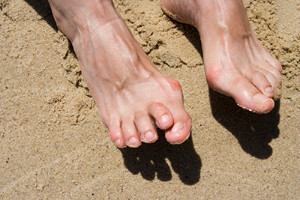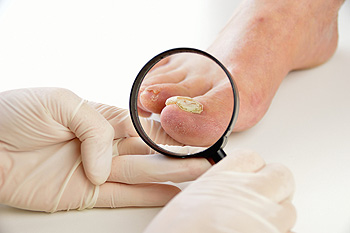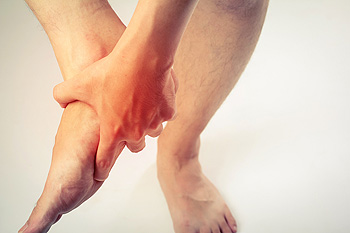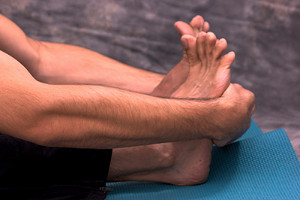July 2019
How to Choose High Heels
 The benefits of wearing high heels can include the legs appearing longer and slimmer. It may come with a price of having foot pain, and this can be the result of the shoes having inadequate room for the toes to move freely in. If the desire is strong to wear high heels, there are a variety of methods that can be implemented which may diminish foot pain. These can include getting your feet properly measured to determine the correct shoe size, keeping the heels about two inches high, and making sure there is enough cushioning and support in the shoe. Additionally, it may be beneficial to choose shoes that have rounded toes, as this can be helpful in preventing bunions, and other foot conditions. If you would like additional information on how high heels can affect your feet, please consult with a podiatrist.
The benefits of wearing high heels can include the legs appearing longer and slimmer. It may come with a price of having foot pain, and this can be the result of the shoes having inadequate room for the toes to move freely in. If the desire is strong to wear high heels, there are a variety of methods that can be implemented which may diminish foot pain. These can include getting your feet properly measured to determine the correct shoe size, keeping the heels about two inches high, and making sure there is enough cushioning and support in the shoe. Additionally, it may be beneficial to choose shoes that have rounded toes, as this can be helpful in preventing bunions, and other foot conditions. If you would like additional information on how high heels can affect your feet, please consult with a podiatrist.
High heels have a history of causing foot and ankle problems. If you have any concerns about your feet or ankles, contact one of our podiatrists from Advanced Foot & Ankle Associates, PLLC. Our doctors can provide the care you need to keep you pain-free and on your feet.
Effects of High Heels on the Feet
High heels are popular shoes among women because of their many styles and societal appeal. Despite this, high heels can still cause many health problems if worn too frequently.
Which Parts of My Body Will Be Affected by High Heels?
- Ankle Joints
- Achilles Tendon – May shorten and stiffen with prolonged wear
- Balls of the Feet
- Knees – Heels cause the knees to bend constantly, creating stress on them
- Back – They decrease the spine’s ability to absorb shock, which may lead to back pain. The vertebrae of the lower back may compress.
What Kinds of Foot Problems Can Develop from Wearing High Heels?
- Corns
- Calluses
- Hammertoe
- Bunions
- Morton’s Neuroma
- Plantar Fasciitis
How Can I Still Wear High Heels and Maintain Foot Health?
If you want to wear high heeled shoes, make sure that you are not wearing them every day, as this will help prevent long term physical problems. Try wearing thicker heels as opposed to stilettos to distribute weight more evenly across the feet. Always make sure you are wearing the proper shoes for the right occasion, such as sneakers for exercising. If you walk to work, try carrying your heels with you and changing into them once you arrive at work. Adding inserts to your heels can help cushion your feet and absorb shock. Full foot inserts or metatarsal pads are available.
If you have any questions please feel free to contact one of our offices located in Lake Worth and Aledo/Willow Park, TX . We offer the newest diagnostic and treatment technologies for all your foot and ankle needs.
What Causes Hammertoe?
 The medical condition that is known as hammertoe occurs when the second and third toes bend downward at the middle joint, causing them to resemble a hammer. This ailment can come from genetic factors, or from wearing shoes that do not have adequate room for the toes to move freely in. Additionally, there may be existing medical conditions which can lead to the development of hammertoes, which can include bunions, or different forms of arthritis. The symptoms that are associated with this condition often include pain in the foot as the toes are stretched downward, and there may be calluses and corns that form on the top of the bent joints. Mild relief may be found when the feet are soaked in warm water, which can make it easier for the toes to stretch by pointing and flexing the ankles. For severe cases of hammertoe, a splint is applied to the affected toes to help keep them as straight as possible. If you have developed this condition, it is strongly suggested that you consult with a podiatrist who can offer treatment options that are correct for you.
The medical condition that is known as hammertoe occurs when the second and third toes bend downward at the middle joint, causing them to resemble a hammer. This ailment can come from genetic factors, or from wearing shoes that do not have adequate room for the toes to move freely in. Additionally, there may be existing medical conditions which can lead to the development of hammertoes, which can include bunions, or different forms of arthritis. The symptoms that are associated with this condition often include pain in the foot as the toes are stretched downward, and there may be calluses and corns that form on the top of the bent joints. Mild relief may be found when the feet are soaked in warm water, which can make it easier for the toes to stretch by pointing and flexing the ankles. For severe cases of hammertoe, a splint is applied to the affected toes to help keep them as straight as possible. If you have developed this condition, it is strongly suggested that you consult with a podiatrist who can offer treatment options that are correct for you.
Hammertoe
Hammertoes can be a painful condition to live with. For more information, contact one of our podiatrists from Advanced Foot & Ankle Associates, PLLC. Our doctors will answer any of your foot- and ankle-related questions.
Hammertoe is a foot deformity that affects the joints of the second, third, fourth, or fifth toes of your feet. It is a painful foot condition in which these toes curl and arch up, which can often lead to pain when wearing footwear.
Symptoms
- Pain in the affected toes
- Development of corns or calluses due to friction
- Inflammation
- Redness
- Contracture of the toes
Causes
Genetics – People who are genetically predisposed to hammertoe are often more susceptible
Arthritis – Because arthritis affects the joints in your toes, further deformities stemming from arthritis can occur
Trauma – Direct trauma to the toes could potentially lead to hammertoe
Ill-fitting shoes – Undue pressure on the front of the toes from ill-fitting shoes can potentially lead to the development of hammertoe
Treatment
Orthotics – Custom made inserts can be used to help relieve pressure placed on the toes and therefore relieve some of the pain associated with it
Medications – Oral medications such as anti-inflammatories or NSAIDs could be used to treat the pain and inflammation hammertoes causes. Injections of corticosteroids are also sometimes used
Surgery – In more severe cases where the hammertoes have become more rigid, foot surgery is a potential option
If you have any questions please contact one of our offices located in Lake Worth and Aledo/Willow Park, TX . We offer the newest diagnostic and treatment technologies for all your foot and ankle needs.
Signs You May Have Toenail Fungus
 The symptoms of toenail fungus are fairly noticeable. An obvious sign that you may have developed this condition often includes a discoloration of the toenail. It will typically start with the big toenail, and will begin by turning a yellowish color. If it is not promptly treated, the nail may become brittle and crumble, and can gradually pull away from the toe. The fungus that causes this condition lives and thrives in warm and moist environments. These include public pools, locker rooms, and shower room floors. When appropriate shoes are worn, the chances of getting toenail fungus may be diminished. If you feel you have developed this condition, it is suggested to consult with a podiatrist who can properly diagnose and treat this condition.
The symptoms of toenail fungus are fairly noticeable. An obvious sign that you may have developed this condition often includes a discoloration of the toenail. It will typically start with the big toenail, and will begin by turning a yellowish color. If it is not promptly treated, the nail may become brittle and crumble, and can gradually pull away from the toe. The fungus that causes this condition lives and thrives in warm and moist environments. These include public pools, locker rooms, and shower room floors. When appropriate shoes are worn, the chances of getting toenail fungus may be diminished. If you feel you have developed this condition, it is suggested to consult with a podiatrist who can properly diagnose and treat this condition.
If left untreated, toenail fungus may spread to other toenails, skin, or even fingernails. If you suspect you have toenail fungus it is important to seek treatment right away. For more information about treatment, contact one of our podiatrists of Advanced Foot & Ankle Associates, PLLC. Our doctors can provide the care you need to keep you pain-free and on your feet.
Symptoms
- Warped or oddly shaped nails
- Yellowish nails
- Loose/separated nail
- Buildup of bits and pieces of nail fragments under the nail
- Brittle, broken, thickened nail
Treatment
If self-care strategies and over-the-counter medications does not help your fungus, your podiatrist may give you a prescription drug instead. Even if you find relief from your toenail fungus symptoms, you may experience a repeat infection in the future.
Prevention
In order to prevent getting toenail fungus in the future, you should always make sure to wash your feet with soap and water. After washing, it is important to dry your feet thoroughly especially in between the toes. When trimming your toenails, be sure to trim straight across instead of in a rounded shape. It is crucial not to cover up discolored nails with nail polish because that will prevent your nail from being able to “breathe”.
In some cases, surgical procedure may be needed to remove the toenail fungus. Consult with your podiatrist about the best treatment options for your case of toenail fungus.
If you have any questions, please feel free to contact one of our offices located in Lake Worth and Aledo/Willow Park, TX . We offer the newest diagnostic and treatment technologies for all your foot care needs.
Different Types of Arthritis in the Feet
 The feet are comprised of numerous bones, joints, and tendons. Patients who are afflicted with arthritis in the feet may notice changes that occur in the arch. Osteoarthritis can affect the joints in the big toe, and the range of motion may become limited. Other symptoms can often include the bones becoming bigger, and a bunion may form on the outside of the big toe. Research has indicated there are several forms of inflammatory arthritis. These include reactive arthritis, gout, and psoriatic arthritis. The former typically affects the heel and ankle. Symptoms of gout often include severe pain and discomfort, and typically affects the big toe. The latter type of arthritis causes dactylitis, which is defined as pain and swelling. If you are suffering from any type of arthritis in the feet, it is suggested to schedule a consultation with a podiatrist who can properly treat this condition.
The feet are comprised of numerous bones, joints, and tendons. Patients who are afflicted with arthritis in the feet may notice changes that occur in the arch. Osteoarthritis can affect the joints in the big toe, and the range of motion may become limited. Other symptoms can often include the bones becoming bigger, and a bunion may form on the outside of the big toe. Research has indicated there are several forms of inflammatory arthritis. These include reactive arthritis, gout, and psoriatic arthritis. The former typically affects the heel and ankle. Symptoms of gout often include severe pain and discomfort, and typically affects the big toe. The latter type of arthritis causes dactylitis, which is defined as pain and swelling. If you are suffering from any type of arthritis in the feet, it is suggested to schedule a consultation with a podiatrist who can properly treat this condition.
Arthritis can be a difficult condition to live with. If you are seeking treatment, contact one of our podiatrists from Advanced Foot & Ankle Associates, PLLC. Our doctors can provide the care you need to keep you pain-free and on your feet.
Arthritic Foot Care
Arthritis is a joint disorder that involves the inflammation of different joints in your body, such as those in your feet. Arthritis is often caused by a degenerative joint disease and causes mild to severe pain in all affected areas. In addition to this, swelling and stiffness in the affected joints can also be a common symptom of arthritis.
In many cases, wearing ill-fitting shoes can worsen the effects and pain of arthritis. Wearing shoes that have a lower heel and extra room can help your feet feel more comfortable. In cases of rheumatoid arthritis, the arch in your foot may become problematic. Buying shoes with proper arch support that contour to your feet can help immensely.
Alleviating Arthritic Pain
- Exercises that stretch the foot can prevent further pain and injury and increase mobility
- Most of the pain can be alleviated with anti-inflammatory drugs, heat, and topical medications
- Massages can help temporarily alleviate pain.
It is best to see your doctor for the treatment that is right for your needs and symptoms. Conditions vary, and a podiatrist can help you determine the right method of care for your feet.
If you have any questions, please feel free to contact one of our offices located in Lake Worth and Aledo/Willow Park, TX . We offer the newest diagnostic tools and technology to treat your foot and ankle needs.
Gout Pain Can Be Managed
Stretching the Calf Muscles May Help the Feet
 Tight calf muscles can lead to uncomfortable foot conditions that include plantar fasciitis, bunions, and tendinitis. There are reasons why calf muscles may be shortened, including genetic factors, wearing high heels for the majority of the day, or problems with posture. When the calf muscles are properly stretched, walking and running activities will typically become easier to perform. An effective calf stretch is done by standing on a step while letting the heel of one foot dip, and then repeating on the other foot. This is helpful in lengthening the Achilles tendon. Those patients who are interested in yoga can perform a downward dog yoga stretch. This is done by placing the hands on the floor, and lifting up and down on the toes. If you would like additional information about the benefits of stretching feet, please consult with a podiatrist.
Tight calf muscles can lead to uncomfortable foot conditions that include plantar fasciitis, bunions, and tendinitis. There are reasons why calf muscles may be shortened, including genetic factors, wearing high heels for the majority of the day, or problems with posture. When the calf muscles are properly stretched, walking and running activities will typically become easier to perform. An effective calf stretch is done by standing on a step while letting the heel of one foot dip, and then repeating on the other foot. This is helpful in lengthening the Achilles tendon. Those patients who are interested in yoga can perform a downward dog yoga stretch. This is done by placing the hands on the floor, and lifting up and down on the toes. If you would like additional information about the benefits of stretching feet, please consult with a podiatrist.
Why Stretching Is Important for Your Feet
Stretching the feet is a great way to prevent injuries. If you have any concerns with your feet consult with one of our podiatrists from Advanced Foot & Ankle Associates, PLLC. Our doctors will assess your condition and provide you with quality foot and ankle treatment.
Stretching the Feet
Stretching the muscles in the foot is an important part in any physical activity. Feet that are tight can lead to less flexibility and make you more prone to injury. One of the most common forms of foot pain, plantar fasciitis, can be stretched out to help ease the pain. Stretching can not only ease pain from plantar fasciitis but also prevent it as well. However, it is important to see a podiatrist first to determine if stretching is right for you. Podiatrists can also recommend other ways to stretch your feet. Once you know whether stretching is right for you, here are some excellent stretches you can do.
- Using a foam roller or any cylindrical object (a water bottle or soda can will do), roll the object under your foot back and forth. You should also exert pressure on the object. Be sure to do this to both feet for a minute. Do this exercise three times each.
- Similar to the previous exercise, take a ball, such as a tennis ball, and roll it under your foot while seated and exert pressure on it.
- Grab a resistance band or towel and take a seat. If you are using a towel, fold it length wise. Next put either one between the ball of your foot and heel and pull with both hands on each side towards you. Hold this for 15 seconds and then switch feet. Do this three times for each foot.
- Finally hold your big toe while crossing one leg over the other. Pull the toe towards you and hold for 15 seconds. Once again do this three times per foot.
It is best to go easy when first stretching your foot and work your way up. If your foot starts hurting, stop exercising to ice and rest the foot. It is advised that you then see a podiatrist for help.
If you have any questions, please feel free to contact one of our offices located in Lake Worth and Aledo/Willow Park, TX . We offer the newest diagnostic and treatment technologies for all your foot care needs.
Blog Archives
- May 2025
- April 2025
- March 2025
- February 2025
- January 2025
- December 2024
- November 2024
- October 2024
- September 2024
- August 2024
- July 2024
- June 2024
- May 2024
- April 2024
- March 2024
- February 2024
- January 2024
- December 2023
- November 2023
- October 2023
- September 2023
- August 2023
- July 2023
- June 2023
- May 2023
- April 2023
- March 2023
- February 2023
- January 2023
- December 2022
- November 2022
- October 2022
- September 2022
- August 2022
- July 2022
- June 2022
- May 2022
- April 2022
- March 2022
- February 2022
- January 2022
- December 2021
- November 2021
- October 2021
- September 2021
- August 2021
- July 2021
- June 2021
- May 2021
- April 2021
- March 2021
- February 2021
- January 2021
- December 2020
- November 2020
- October 2020
- September 2020
- August 2020
- July 2020
- June 2020
- May 2020
- April 2020
- March 2020
- February 2020
- January 2020
- December 2019
- November 2019
- October 2019
- September 2019
- August 2019
- July 2019
- June 2019
- May 2019
- April 2019
- March 2019
- February 2019
- January 2019
- December 2018
- November 2018
- October 2018





